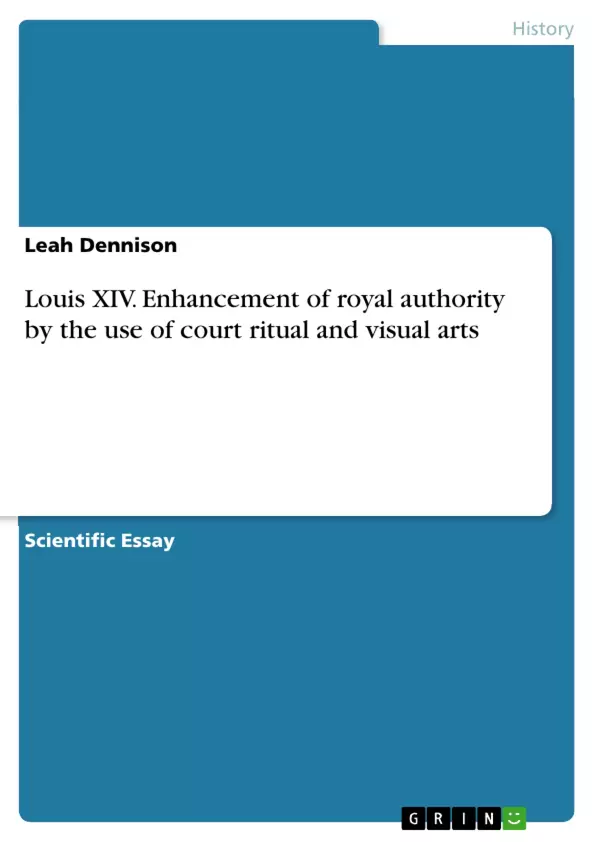Louis XIV was known as ‘the Sun King’ and his control over the culture of court life at the notorious palace of Versailles and his use of the visual arts were not only ways to celebrate the rule of 'le Roi-Soleil' but also an attempt to enhance royal authority. In his ‘Memoires’, Louis argued that it was essential for the monarch to be constantly visible and accessible to his subjects. France in 1610 was very unstable and it wasn't until the introduction of Richelieu by 1624 that a more cohesive policy of representation could be followed. By the end of Louis XIII's reign, in 1643 France had faced much noble discontent and rebellion, there was limited manipulation of the visual arts and court ritual. This was due to the contrasting aims of Louis XIII who had to secure his position before attempting to make a decisive strategy of the delivery of his public image.
Inhaltsverzeichnis (Table of Contents)
- Introduction
- Louis XIII and the Early Years of his Reign
- Richelieu and the Rise of Propaganda
- Court Ritual under Louis XIII
- The Fronde and the Rise of Louis XIV
- Versailles and the Glorification of the Sun King
- The Visual Arts and Royal Authority
- The Target Audience of Royal Propaganda
- Versailles and the Control of the Nobility
- Court Ritual and the Exercise of Royal Authority
Zielsetzung und Themenschwerpunkte (Objectives and Key Themes)
This essay aims to examine the extent to which Louis XIV was successful in using court ritual and the visual arts to enhance royal authority during the period 1610-1715. It explores the evolution of these strategies from the unstable early years of Louis XIII's reign to the establishment of the lavish court of Versailles under Louis XIV.
- The role of court ritual and the visual arts in shaping royal authority
- The development of propaganda techniques under Louis XIII and Louis XIV
- The impact of the Fronde on Louis XIV's approach to governance
- The significance of Versailles as a symbol of absolute monarchy
- The use of art and ceremony to control the nobility and maintain social stability
Zusammenfassung der Kapitel (Chapter Summaries)
- Introduction: This section introduces the topic of Louis XIV's use of court ritual and the visual arts to enhance royal authority, outlining the key themes and arguments of the essay.
- Louis XIII and the Early Years of his Reign: This chapter examines the unstable early years of Louis XIII's reign, highlighting the challenges faced by the monarchy and the limited use of court ritual and the visual arts in this period.
- Richelieu and the Rise of Propaganda: This chapter explores the emergence of propaganda techniques under Richelieu's leadership, focusing on his use of writers, government newspapers, and institutions like the Academie to promote the king's image and principles.
- Court Ritual under Louis XIII: This chapter discusses the limited development of court ritual during Louis XIII's reign, due to the frequent movement of the court and the lack of a fixed location.
- The Fronde and the Rise of Louis XIV: This chapter examines the impact of the Fronde on Louis XIV's approach to governance, highlighting the lessons learned from the civil war and the shift towards a more absolutist style of rule.
- Versailles and the Glorification of the Sun King: This chapter explores the significance of Versailles as a symbol of absolute monarchy, focusing on its design, its use as a canvas for art and propaganda, and its role in solidifying Louis XIV's image as the "Sun King."
- The Visual Arts and Royal Authority: This chapter examines the various ways in which Louis XIV used the visual arts to broadcast his victories, enhance his image, and project French power both domestically and internationally.
- The Target Audience of Royal Propaganda: This chapter discusses the different audiences targeted by Louis XIV's propaganda, including posterity, the French upper classes, and foreign courts.
- Versailles and the Control of the Nobility: This chapter explores the role of Versailles in controlling the nobility, highlighting the use of court ritual and etiquette to maintain social stability and prevent rebellion.
- Court Ritual and the Exercise of Royal Authority: This chapter analyzes the intricate system of court ritual and etiquette at Versailles, arguing that it was an integral part of Louis XIV's strategy for maintaining royal authority.
Schlüsselwörter (Keywords)
This essay explores the themes of royal authority, court ritual, the visual arts, propaganda, absolutism, and the French monarchy. It examines the development of these concepts during the reigns of Louis XIII and Louis XIV, focusing on the construction of the "Sun King" image and the role of Versailles in shaping French society.
- Quote paper
- Leah Dennison (Author), 2013, Louis XIV. Enhancement of royal authority by the use of court ritual and visual arts, Munich, GRIN Verlag, https://www.grin.com/document/279628



